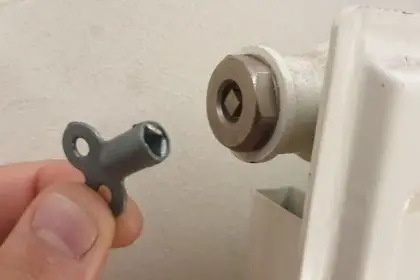Radiators are a common feature in most homes. They provide heating and cooling, as well as a decorative element to your home’s interior design. However, you may not know that they can cause some problems if they aren’t properly maintained. This includes bleeding your radiator.
Many people will tell you that radiators need to be bled when they are cold, but this isn’t actually the case! It can sometimes take several hours for a radiator to cool down enough so it is safe to bleed them.
It is however better to bleed your radiators when they are cold. This is because they will be at their lowest pressure, and there is less risk of you causing any damage to the radiator or yourself if something goes wrong.
Remember that bleeding your radiators isn’t as simple as turning a stopcock and letting fluid run out: it requires specific tools and knowledge about how heating systems work. If in doubt, always contact an expert rather than attempting this process on your own.
Why Bleed Your Radiators?
There are several reasons why bleeding your radiators is important. First, it allows the air to escape from the system so that you can get the maximum heat out of them.
Second, you won’t get issues with air bubbles traveling through your heating system.
Finally, it means that the heating system is fully primed and ready to go whenever you need it.
How To Bleed Your Radiators
It’s important to be careful when bleeding your radiator as there are some risks involved. You will usually need a special tool called a bleed key which allows you to open up the valve on your radiators easily even if they’re hot.

If this isn’t something you have then make sure that your stopcock matches with the size of the screw thread on top of each individual radiator before attempting anything yourself – otherwise call in an expert.
When you’ve got everything set up properly, follow these steps:
- Get an old rag or towel to place underneath your radiator.
- Remove the radiator cap and cover it with a rag.
- Take hold of the bleed key and insert into inlet port on top of radiator tank (you may need to wiggle this in).
- Open up valve slowly so that only air is released, not fluid. You should hear a hissing sound as the air leaves the radiator system.
- You should see bubbles coming out which is what we want! Wait for these to go down before starting again if they haven’t disappeared completely after half a minute or so. Repeat step five until there are no more bubbles escaping from your system. This means all air has been purged from your heating system.
- Close the valve by hand and replace radiator cap.
Once you’re finished, remember to keep your radiator bleed key somewhere that’s easy to remember. I’ve lost mine loads of times which is why I keep it in a key compartment of my toolbox.
What happens if you bleed a radiator with the heating on?
Bleeding a radiator that is turned on will very often cause some damage. You don’t want to bleed your radiator while the heating is on. If you do, the hot water will be expelled from the system and may cause damage to your flooring or other property.
Bleeding a radiator with the heating turned up can force boiling-hot water out of it. Leading to serious problems like burned carpet, damaged hardwood floors, or even cracked tiles. It would also result in wasted energy usage if you had already planned on running your boiler for several hours.
To avoid any risk, turn off all radiators before bleeding them following these simple steps:”
- Go to your thermostat and adjust temperature setting so that no heat is being produced.
- Wait for a while to allow the temperature in your radiators drop.
- Go to your boiler and turn off the water supply.
- You may need some plumbers putty or tape on hand if you have a stopcock that leaks at higher pressures.
- Proceed to blled your radiators as described above.
- Bleeding radiators is an important part of how heating systems work, so don’t be tempted to do it yourself unless you know what you are doing. It can lead to serious damage and wasted energy usage if not carried out correctly – call in an expert instead who knows all there is about this process.
How To Bleed A Radiator: Methods and Tools
If you are happy to bleed your radiators while they are hot or cold then it’s time to learn how exactly to do this. It might take several hours for the radiator itself to cool down enough that you can open up its valve safely but we’ll assume that isn’t the case!

Make sure all of your valves are closed before starting (if they aren’t already). There should be an inlet screw thread on top of each individual radiator which looks like a small circle with threads running around it vertically – make sure not to confuse these with stopcocks if any other kind is present.
Use a lint-free rag to cover each valve before unscrewing the cap.
Using your radiator bleed key- these can be bought separately or come as part of screwdriver sets – insert it into the inlet port on top of your radiators and open up slowly by hand so that only air is released.
Once you’ve done this, wait for bubbles to stop appearing before starting again if they haven’t disappeared completely after half a minute or so. Repeat until no more bubbles appear and the system has been purged of all air- put your key away safely.
How often should I bleed my radiators?
You don’t need to bleed your radiators every time they are used but there are certain circumstances where bleeding them more regularly may be necessary.
If someone new has moved into an empty room in your home or if you’ve purchased an old property that hasn’t been lived in for several years.
This way, all the air bubbles from lack of use can be removed from the heating system completely before it begins its job of heating up your home.
If you have a gas boiler that is constantly being turned on and off throughout the day then it’s possible that air bubbles could be trapped in the system from regular use.
Irregular use of a gas boiler can also be a reason to bleed your radiators. If your heating system has been switched off throughout the summer, then bleeding your radiators is a good way to remove all the air from your system.
In these cases, bleeding should happen more regularly to ensure there are no issues with the heating – every time you turn your central heating back on.




